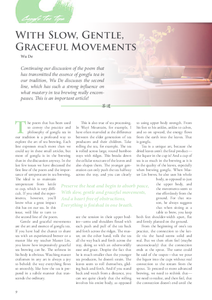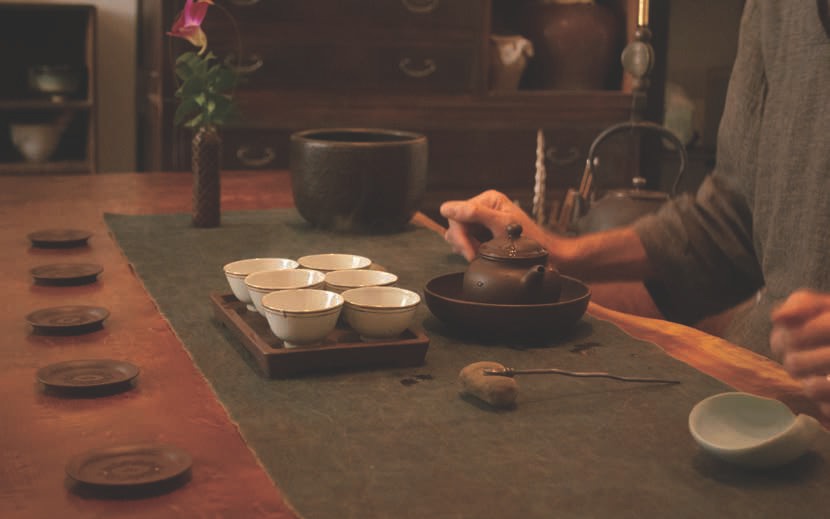
 |
|

Preserve the heat and begin to absorb peace, With slow, gentle and graceful movements, And a heart free of obstructions, Everything is finished in one breath.
The poem that has been used to convey the practice and philosophy of gongfu tea in our tradition is a profound way to explore the art of tea brewing. Each line expresses much more than we could say in these small articles, but more of gongfu is in the brewing than in the discussion anyway. In the last few issues we have discussed the first line of the poem and the importance of temperature in tea brewing. The ideal is to maintain temperature from kettle to cup, which is very difficult. If you tried the experiments, however, you'll know what a great impact this has on our tea. In this issue, we'd like to turn to the second line of the poem.
Gentle and graceful movements are the art and essence of gongfu tea. If you have had the chance to share tea with an experienced brewer or a master like my teacher Master Lin, you know how impressively graceful tea brewing can be. The softness in his body is obvious. Watching master craftsmen in any art is always a joy to behold: the way everything flows so smoothly, like how the tea is prepared in a subtle manner that transcends the ordinary.
This is also true of tea processing. In Wuyi Mountain, for example, I have often marveled at the difference between the elder generation of tea producers and their children. Take rolling the tea, for example. The tea is rolled across large, round bamboo trays with ridges. This breaks down the cellular structure of the leaves and also shapes them. The younger generation can only push the tea halfway across the tray, and you can clearly see the tension in their upper bodies - arms and shoulders flexed with each push and pull of the tea back and forth across the ridges. The master, on the other hand, rolls the tea all the way back and forth across the tray, doing so with an otherworldly ease and grace. Despite the fact that he is much smaller than the younger tea producers, he doesn't strain. The leaves seem to roll themselves, gliding back and forth. And if you stand back and watch from a distance, you can see quite clearly that the rolling involves his entire body, as opposed to using upper body strength. From his feet to his ankles, ankles to calves, and so on upward, the energy flows from the earth into the leaves. That is gongfu.
Tea is a unique art, because the dried leaves aren't the final product - the liquor in the cup is! And a cup of tea is as much in the brewing as it is in the quality of the leaves, especially when brewing gongfu. When Master Lin brews, he also uses his whole body, as opposed to just the upper body, and the movements seem to rise effortlessly from the ground. For that reason, he always suggests that when sitting at a table to brew, you keep both feet shoulder-width apart, flat and firmly planted on the ground.
From the beginning of one's tea practice, the connection to the kettle via the hand seems solid and real. But we then often feel (maybe unconsciously) that the connection ends at the spout. The same could be said of the teapot - that we pour the liquor into the cups without real connection to the stream from the spout. To proceed to more advanced brewing, we need to rethink that - we need to realize, and then feel, that the connection doesn't end until the cup is in the hands of our guest(s). I always teach my students to never, ever pour the water into the pot, but rather place it there. The same principle applies when distributing the liquor into the cups: gently place it, feeling your connection to the cups. The whole process is connected, physically and spiritually. And it is only when we begin to sense this connection that we can really begin to express the essence of the second line of our poem. During your next session, try feeling the connection of the kettle to your arm, to your body, your feet and even the ground. Then try to see if you can feel the difference when you place the water in the pot and place the liquor in the cups, guiding the entire effort from the beginning, which is in the ground.

To achieve "gentle and graceful" movements will take some time and skill (gongfu) - a lot of which will come only after years of tea brewing, when the process itself is ingrained in our bodies. However, the "slow" part is something we can practice no matter what level of gongfu we have achieved. And that is the aspect of this line of the poem that we'd like you to focus on this month.
Make a practice of staying with the tea. That is one of the basics of all tea brewing, bowl tea or gongfu. After you pick up the kettle, put all your awareness and attention into the brewing. Try brewing tea with your complete self. Focus and attention to every detail is the beginning of more masterful brewing (gongfu). There is a Chinese tradition of pausing conversation during the actual brewing, as it is said that the words will be steeped into the tea and come out in the cup. Such pauses are great for more heartfelt dialogue, as they allow us the time to reflect, listen to our guest(s) and respond properly. Gaps also allow us to concentrate and brew with a one-pointed, meditative mind. This will surely have a profound effect on the tea we prepare.
For this month's experiment try brewing with these three principles, whether you have practiced them before or not. Make an effort to have a single session where they are the focus and intention of your brewing. First, practice brewing from the ground. This may be easier if you sit cross-legged on the floor. Otherwise, do as Master Lin suggests and place your feet shoulder-width apart and plant them firmly. Either way, try bringing the energy that will move your arms and hands up from the ground, through the center of your body. Second, make a strong effort to slow everything down. Do each movement slowly and carefully. Finally, stay with the tea. Don't let a single drop of your attention wander. Put every bit of your focus and concentration into the brewing, following the connection between each of the steps. Pay attention to what changes when you brew tea this way. Maybe you can invite a friend over who you often share tea with and ask them about what they found different in your tea brewing this time.
We hope that these discussions of our beloved poem will help give you some insights into the spirit and practice of gongfu tea, as well as real ways you can progress in your tea brewing. And, as always, share the results with us. It is always great to hear your insights...
